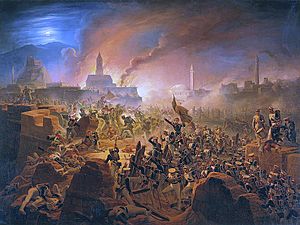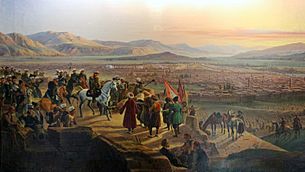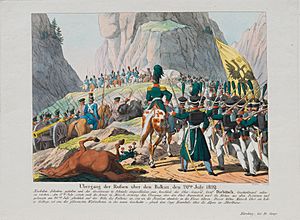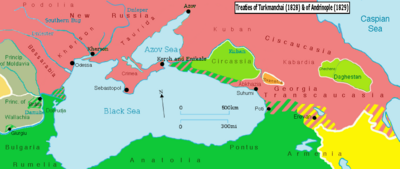Russo-Turkish War (1828–1829) facts for kids
Quick facts for kids Russo-Turkish War (1828-1829) |
|||||||||
|---|---|---|---|---|---|---|---|---|---|
| Part of Russo-Turkish Wars, Russian conquest of the Caucasus, and Greek War of Independence | |||||||||
 Battle of Akhalzic (1828), by January Suchodolski. Oil on canvas, 1839 |
|||||||||
|
|||||||||
| Belligerents | |||||||||
|
|
||||||||
| Commanders and leaders | |||||||||
|
|
||||||||
| Strength | |||||||||
| 100,000 | Unknown | ||||||||
| Casualties and losses | |||||||||
The Russo-Turkish War of 1828–1829 was a big conflict between the Russian and Ottoman Empires. It started because of the Greek War of Independence. The war began when the Ottoman ruler, Mahmud II, stopped Russian ships from using the Dardanelles strait. He also canceled an earlier agreement called the Akkerman Convention. This was his way of reacting to Russia helping Greece in the Battle of Navarino in 1827.
After losing several battles, the Sultan decided to ask for peace. This led to the Treaty of Adrianople, which was signed on September 14, 1829.
Contents
Fighting in Europe: The Balkan Front
When the war began, the Russian army had 100,000 soldiers. They were led by Emperor Nicholas I. The Ottoman forces were commanded by Agha Hussein Pasha.
Russian Advance into Ottoman Lands
In April and May 1828, the Russian commander, Prince Peter Wittgenstein, moved his troops into the Danubian Principalities. These were areas now part of Romania. In June 1828, the main Russian forces, led by the Emperor himself, crossed the Danube River. They then moved into a region called Dobruja.
The Russians then tried to capture three important Ottoman forts in what is now Bulgaria. These were Shumen, Varna, and Silistra. With help from the Black Sea Fleet, Varna was captured on September 29.
Tough Battles and Retreats
The Siege of Shumen was much harder. The Ottoman army there had 40,000 soldiers, which was more than the Russians. The Russian soldiers faced constant attacks and were not well-supplied. Many got sick or were too tired to fight. Because of this, Russia had to pull back to Moldavia. They suffered heavy losses and did not capture Shumen or Silistra that year.
As winter came, the Russian army had to leave Shumen and go back to Bessarabia. In February 1829, a new, more active commander, Hans Karl von Diebitsch, took over from Wittgenstein. The Tsar also left the army and returned to Saint Petersburg.
New Attacks and Victories
On May 7, 60,000 Russian soldiers led by Diebitsch crossed the Danube again. They restarted the siege of Silistra. The Sultan sent 40,000 soldiers to help Varna, but they were defeated at the Battle of Kulevicha on May 30. Three weeks later, on June 19, Silistra fell to the Russians.
On July 2, Diebitsch launched a bold attack across the Balkan mountains. This was the first time a Russian army had done this since the 10th century. About 35,000 Russian soldiers moved through the mountains. They went around the besieged fort of Shumla on their way to Constantinople, the Ottoman capital. The Russians captured Burgas ten days later. Turkish reinforcements were defeated near Sliven on July 31. By August 22, the Russians had taken Adrianople. Many Muslim people living in the city reportedly left. The Edirne Palace was badly damaged by Russian troops.
Fighting in Asia: The Caucasus Front
Even though the main battles were in Europe, there was also important fighting in the Caucasus region. The Russian general Ivan Paskevich had several goals here. He wanted to keep as many Turkish soldiers busy as possible. He also aimed to capture Turkish forts on the Black Sea coast. These forts helped the Circassians and could be used to land more troops. Finally, he wanted to move the border further west.
Most of the Turkish fighters were led by the Pasha of Akhaltsikhe and Muslim Georgian leaders. The city of Kars was important because it blocked the road from Akhaltsikhe to Erzurum. Erzurum was the main city in eastern Turkey. The Russo-Persian War (1826–28) had just ended, which removed a big threat for Russia. Paskevich had only 15,000 soldiers to fight the Turks. This was because two-thirds of his troops were busy guarding the Caucasus and watching the Persians. The Turks delayed their attack, giving Paskevich time to move his troops and supplies west, gathering them at Gyumri near the border.
1828: Key Victories in the Caucasus
Capturing Kars
On June 14, Paskevich marched towards Kars, about 40 miles southwest. Kars was defended by 11,000 Turkish soldiers and 151 cannons. The capture of Kars happened almost by accident. During a small fight outside the city, a group of Russian soldiers advanced without orders. Other companies rushed to help them. This drew in more soldiers until most of the Russian force was in one spot. The city wall was broken through, and soon the Turks only held the main fort. At 10:00 am on June 23, the fort surrendered. The Turks lost 2,000 killed or wounded, and 1,350 were taken prisoner. They also lost 151 cannons. Most of their soldiers managed to escape. The Russians lost 400 killed or wounded. Kios Pasha of Erzurum was very close to Kars, but when he heard the news, he pulled back to Ardahan.
Taking Akhalkalaki
Paskevich then pretended to go towards Erzurum but instead marched north to Akhalkalaki. He attacked the city first with his artillery. Under the heavy shelling, the 1,000 Turkish soldiers defending the city lost hope. Half of them tried to escape by climbing down the walls using ropes. However, most of them were killed. The Russians then used the same ropes to climb the walls and enter the city. The remaining 300 Turkish soldiers surrendered on July 24.
The Siege of Akhaltsikhe
About 30 miles northwest of Akhalkalaki was Akhaltsikhe. It had 10,000 defenders led by a local Pasha. This city guarded the Borjomi Gorge, a pass that led northeast to Georgia. Instead of taking the main road, Paskevich and 8,000 men marched for three days through difficult land. They reached Akhaltsikhe on August 3. The next day, Kios Pasha and 30,000 men set up camp four miles from the fort. Paskevich was outnumbered, with enemies on two sides. He decided to attack Kios first. After a day-long battle, Kios and his 5,000 infantry soldiers fled into the Akhaltsikhe fortress. The rest of the Turkish forces scattered south to Ardahan. In this battle, the Russians lost 531 men, including a general. But they captured a lot of Turkish supplies.
Paskevich and his troops then began to besiege Akhaltsikhe. The city had three layers of defense: the town itself with its narrow streets and strong points, the main fortress, and a smaller fort inside. When the attack started at 4:00 pm, the people of the town fought back bravely. But by nightfall, the town was on fire. In one mosque, many people died in the fire. By dawn on August 16, the ruined town was in Russian hands. The Russians then moved their cannons closer to fire on the fortress walls. On August 17, Kios Pasha surrendered the fortress and the smaller fort. He and his remaining 4,000 men were allowed to leave with their weapons and belongings. During the battle, the Russians lost about 600 men, while the Turks lost 6,000.
The next day, Paskevich attacked and captured Atskhur castle. This castle guarded the Borjomi Gorge, which connected Akhaltsikhe northeast to Georgia. On August 22, the Russians took Ardahan. This was an important road junction connecting Akhaltsikhe-Akhalkalaki to the Kars-Erzurum road. Seeing no more chances to advance, the Russians went to their winter camps.
1829: Renewed Fighting and Erzurum's Fall
Kios Pasha was replaced by Salih Pasha. In February 1829, Akhmet Beg and 15,000 Lazes and Adjars took the town of Akhaltsikhe and surrounded the fortress. Twelve days later, Russian Commander Burtsov fought his way through the Borjomi Gorge. The Adjars then fled with their stolen goods. General Hesse also pushed back a Turkish attack from Batum. He captured the Turkish camp of Limani, south of Poti. Far to the southeast, Bayazid was surrounded by the Pasha of Van. The main Turkish attack began in mid-May. Kiaghi Bek approached Ardahan but was pushed north to Adjaria. There, he threatened Akhaltsikhe. He was defeated at Digur, south of Akhaltsikhe. The Russians then went south to join Paskevich at Kars.

Saganlug and Erzurum
On June 13, Paskevich (with 12,340 infantry, 5,785 cavalry, and 70 cannons) left Kars for Erzurum. The Turks had 50,000 soldiers, including 30,000 new-model infantry. They were positioned between Hasankale and Zivin on the Erzurum-Kars road. Further east, an advanced force of 20,000 men under Haghki Pasha held the Millidiuz Pass over the Saganlug mountain. Paskevich chose to take a less-used road to the north. He placed himself near Zevin, between the two Turkish armies. His plan was to attack Haghki Pasha from behind.
There were many complex moves and small battles. At 7:00 pm on June 19, Paskevich attacked and completely defeated the western Turkish army. The next day, he turned east and captured Haghki Pasha and 19 cannons. Most of Haghki Pasha's soldiers managed to escape. With the Turkish armies out of the way, Paskevich headed for Erzurum. On June 27, the city surrendered. It had not seen Christian soldiers inside its walls for five centuries.
After Erzurum
From Erzurum, the main road led northwest through Bayburt to Trebizond on the coast. Trebizond was a very strong place that could only be taken with a navy. But the Russian fleet was busy on the Bulgarian coast. In July, Russian Commander Burtsov went up this road and was killed at Hart. To restore Russia's reputation, Paskevich destroyed Hart on July 28. He sent an army west and brought it back. He went up the Trebizond road, saw that nothing could be achieved there, and returned to Erzurum. Generals Hesse and Osten-Sacken pushed north towards Batum and then returned. The Pasha of Trebizond moved against Bayburt but was defeated on September 28. This was the last battle of the war.
The Peace Treaty: Treaty of Adrianople
The Treaty of Adrianople was signed on September 14, 1829. It took a month for the news to reach Paskevich. In October, his army began marching home.
Facing many defeats, the Sultan decided to ask for peace. The Treaty of Adrianople gave Russia most of the eastern shore of the Black Sea. It also gave Russia control of the mouth of the Danube River. Turkey recognized that Russia now ruled parts of what is today northwest Armenia. Serbia gained more self-rule. Russia was allowed to occupy Moldavia and Wallachia (two regions that are now part of Romania). This was to guarantee their well-being and "freedom of trade" until Turkey paid a large amount of money. Moldavia and Wallachia remained under Russian protection until the Crimean War. The issue of who controlled the Dardanelles and Bosphorus straits was settled four years later. Both powers signed the Treaty of Hünkâr İskelesi.
The Treaty of Adrianople also helped Greece. The Ottoman Sultan finally recognized the independence of the Kingdom of Greece. Later, a famous writer named Karl Marx wrote that it was General Hans Karl von Diebitsch, who invaded through the Balkans, who truly helped solve the Greek situation.
See also
- Russo-Persian War (1826–28)
- Greek War of Independence



